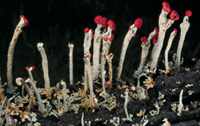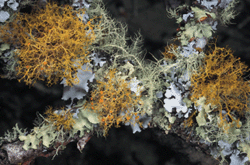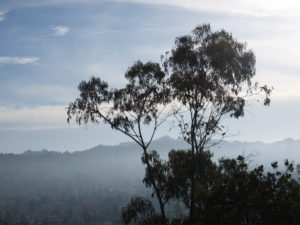As California’s long dry season fades and the winter rains set in, lichens suddenly stand out in the landscape. Fragments blown from trees litter trails and walkways. Colors on trees, rocks, and fences take on a new vibrancy. Boulders crowned by brilliant orange also wear splotches of pale yellow, chartreuse, pink and red, gray-green, brown, and black. In the Rock Springs area of Mount Tamalpais, a rock face no bigger than your hand contains so many different colors, it looks like a discarded artist’s palette. These bright displays belong to lichens, organisms that we often overlook but that permeate the Bay Area environment. In fact, they are essential to it: They provide shelter and food for animals, birds, and insects, and they help to create and stabilize soil.
Lichens can—and do—grow on sidewalks, trees, fence posts, barnacles, tombstones, and shrubs. Several are likely to be present just outside your front door, where they are slowly adding their astonishing architecture to the world we walk through daily but don’t often stop to observe.
Lichens’ minute and intricate structure comes to life only on close inspection. Tiny colored perforations pierce the bodies of some; disks or cups containing spores sprout from others. Thin fingers capped by little red hats pop up on one species, and small volcanoes erupt in black spores on another.
A lichen’s whimsical architecture can be fascinating to look at, and its underlying structure is equally unusual and complex. Although it appears to be one entity, a lichen is actually a composite organism, a marriage between a fungus and a plant. More technically, lichens consist of a threadlike fungus entwined with an alga or a cyanobacteria. Twenty-three different genera of unicellular green algae and twelve genera of cyanobacteria (formerly called blue-green algae) can be found in these lichen partnerships. In all cases, the algal member of the pair can be seen only under a microscope; the fungus is the visible component. Lichens are considered part of the Fungi Kingdom and take their scientific name from the fungal partner. These odd couples live together successfully with a clear division of labor: The algae produce the food—manufacturing sugars and starches photosynthetically that the fungi cannot produce—while the fungi provide moisture, structure, and shelter against ultraviolet radiation for the algae.
However, this is a “marriage” that never gets consummated. Because lichens are made up of two separate organisms from two separate kingdoms, the partners must reproduce independently, and then hope their offspring will hook up in some fashion. This is no simple matter, and the methods vary. As noted lichenologist Mason Hale said, “The actual modes of reproduction . . . remain a complex [and] little understood process, and no other aspect of lichenology is so poorly known and intractable to experimental study.” Many lichens replicate themselves when pieces containing entwined fungal and algal cells are broken off and dispersed by wind, rain, birds, or insects. If this lichen fragment lands in suitable habitat, it can start to grow and establish a new lichen colony.
In other species, the fungal partner divides sexually and releases spores. The germinating spore must then find an algal mate and a suitable spot to attach. It can do this either by accident of dispersal or by robbing a neighbor. For example, over the course of several years, Janet Doell, founder of the California Lichen Society, observed a small grayish-white lichen on a rock formation taking over the territory of a larger lichen by capturing its alga. The victorious lichen eventually replaced the captured alga with one apparently more to its taste, in the process killing off the donor lichen and occupying its territory. As Doell says, “Lichens are not all peace and serenity.”
- Competition among lichens for space can be intense. On this branchin Sonoma County, at least four species are visible. The greenbranching one is a species of Usnea; the whitish folliose is a Parmotrema; the orange fruticose lichen is Teloschistes exilis, quite rare in the Bay Area; and the greenish foliose is likely a Flavopunctelia.
Worldwide, 14,000 species of lichen have been identified; of these, about 1,200 are found in California, many of them in the Bay Area. Wherever lichens may appear, they fall into three categories. Crustose lichens are flat, often scaly, wartlike, or granular; they attach firmly to the surfaces, such as rock faces, on which they grow. Foliose lichens are leaflike and grow closely attached to bark, soil, or rock, but with distinct upper and lower surfaces. Some of the more eye-catching lichens in the area are fruticose: shrubby or pendulous forms that cling to a surface at one point or, in some cases, are not attached at all.
The three lichen forms all lack vascular systems (the conductive vessels that transport water and sugar in plants). They absorb water rapidly and dry out almost as quickly, and they can survive after losing up to 98 percent of their water content. In drying out, lichens become compacted and opaque. This allows the fungi to more effectively shield the algae within and enables the algae to live in environments where they could not survive alone, such as the exposed dry surface of a rock. The desiccated algae remain dormant until dust and rain, fog or dew provide the minerals and water necessary (along with sunlight and carbon dioxide) for photosynthesis. Most lichens grow very slowly—some only a few millimeters in a century—and some individual lichens are believed to be among the oldest living things on earth.
Lichen pigment, which determines the organism’s color, also plays a protective role by shielding the lichen from too much ultraviolet light and keeping it from becoming desiccated. The most deeply colored lichens—the yellow, orange, and brown species—are often found in dry, exposed habitats. In some species color can also change depending on the amount of light available. One lichen, Xanthoria parietina, is greenish if growing in the shade and orange in the sun. Some lichen color is influenced by moisture. Pertusaria amara, a bitter-tasting, powdery lichen often found on oak bark, is white in summer but turns a brilliant green with the first rains.
Just as lichen competition and courtship are shrouded in mystery, lichen chemicals and their functions have not been fully explored. What is known is that lichens generate a complex array of chemicals, among them weak phenolic acids that are specific to individual lichens and are related to the tannins found in some vascular plants. Interestingly, neither lichen partner growing alone produces the chemicals characteristic of their partnership.

- Cladonia transcendens growing on a mossy, rotting log near Arcata.It is also found in the Bay Area on downed logs and rotting beams andshingles.
Lichens thrive on rocks whose minerals their acids will etch, allowing them to take hold. (Certain lichens flourish on oaks because oak bark provides the acid environment many of them prefer.) Some species thrive on iron- or magnesium-rich rocks, while others prefer calcareous sandstones or even concrete and mortar. The carbonic acid produced by lichens’ normal metabolism dissolves these substrates and allows the fungal tendrils (called hyphae) to penetrate their surface. This begins the process of producing soil—one of the key roles lichens play in the environment. Mosses and other primitive plants become established in the newly forming soil and lead the way for more advanced plants and small animals.
Lichens also provide shelter and food for insects, even as those same insects provide food for birds. Not surprisingly, scientists have observed that birds are more plentiful in forests where lichens are also abundant. Birds use lichens as their cupboards, storing insects that have been caught. Many birds (50 species nationwide) also use lichens as nesting material. The outsides of hummingbird nests are often meticulously wrapped in gray-green lichens; the long, pendulous nests of bush­tits are heavily decorated with lichens; and blue-gray gnatcatchers use lichens secured by threads of spiderwebs in their nests.
Highly useful in the environment, lichens have never found much of a commercial market, although some produce chemicals that have antibiotic and antifungal properties. Native Amer­icans employed these substances in ointments, as do contemporary Europeans and Japanese. Because of its generous yardage and absorbent qualities, lace lichen was used by Native Americans in Northern California for diapering and as menstrual pads. One Southern California tribe (Kawaiisu) thought that this lichen had magical properties and placed it in water to bring rain and in fire to drive away thunder and lightning. Both Native Americans and Europeans used lichens as a source of dyes.
One modern use of lichens is monitoring air pollution. Like blotting paper, lichens sop up contaminants in rainwater and fog but have no way to excrete them. When exposed to high levels of pollution, many lichens fail to grow, cease to show reproductive structures, lose color and blacken, and ultimately die. Sulfur dioxide, a major component of urban smog, builds up in the organism and destroys the chlorophyll, leading to death. Lichens are useful in the monitoring of heavy metals, fluorides, radioactivity, aromatic hydrocarbons, ozone, and sulfur and nitrogen oxides. Although no monitoring studies are now occurring in the Bay Area, some years ago, a biology student at Stanford University made a study of lead content in lichens at Jasper Ridge Biological Preserve on the Peninsula. He found that lichens near Highway 280 did indeed have a much higher lead content than those some distance away. Research projects on the impact of pollutants on lichen are ongoing in Southern California, in Red- wood National Park in Northern California, around Lake Michigan, in the Pacific Northwest, and in the British Isles and Europe.
Lichens are not hard to find in the Bay Area. The gauzy blue-green netting of lace lichens (Ramalina menziesii—often mistakenly called Spanish moss) festoons many Bay Area oaks. A drive along Skyline Boulevard on the Peninsula reveals old man’s beard (Usnea sp.), a yellowish-green lichen growing from a central cord that gives it a somewhat stringy appearance. As Alpine Road descends from Skyline toward the coast, a mixture of Usnea and Ramalina takes over. Then Ramalina dominates as the land flattens out. Here, as in the drier foothills, patches of bright orange and red-orange lichens cling to exposed rocks. These specimens are so brilliant that they are easy to spot on the trail, but not as easy to identify. Two orange lichens ubiquitous in the Bay Area are members of the Caloplaca and Xanthoria genera. Yellower, almost granular ones might be suspects from the genus Candelaria. Such lichens are notoriously difficult for even the experts to key, and in some cases chemical tests and microscopic examination of spores are needed.
Of course, you don’t have to know the difference between a Lecanora and a Xanthoparmelia to enjoy lichens. Perhaps the next time you go out for a walk, you’ll take a hand lens and spend some time getting to know the miniature world of your quiet but colorful neighbors.

.jpg)




